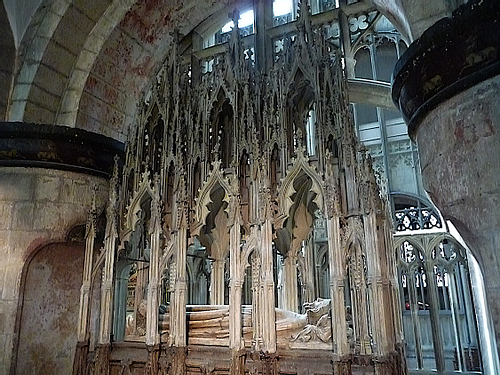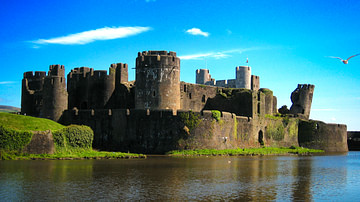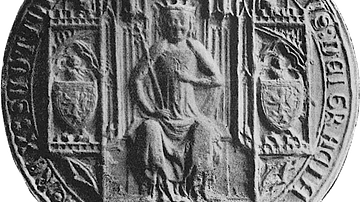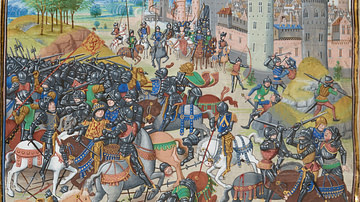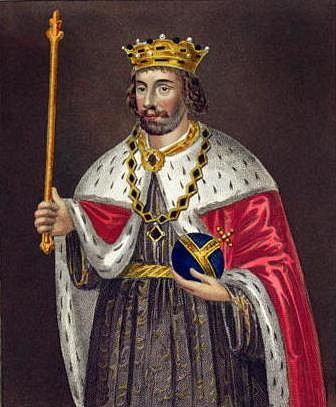
Edward II of England reigned as king from 1307 to 1327 CE. Succeeding his father Edward I of England (r. 1272-1307 CE), his reign saw a disastrous defeat to the Scots at Bannockburn in June 1314 CE, and the king's lack of political and military talents as well as his excessive patronage of friends resulted in his kingdom descending into anarchy. Forced to abdicate by his wife Isabella of France and her lover Roger Mortimer, Edward II was imprisoned and then murdered in Berkeley Castle in September 1327 CE. Edward was succeeded by his young son who became Edward III of England (r. 1327-1377 CE).
Personal Qualities
Edward was born on 25 April 1284 CE at Caernarfon Castle in Wales, the son of Edward I of England and Eleanor of Castile (b. c. 1242 CE). The prince was athletic, intelligent and keen on the arts but was prone, like most of his Plantagenet ancestors, to a violent and stubborn temper. Another peculiarity was Edward's passion for manual labour and skills like thatching rather than such traditional knightly pursuits as the medieval tournament. Edward had three elder brothers, but these had all died by the end of 1284 CE, leaving the prince as heir to the throne at a somewhat empty court and perhaps explaining his tendency to spend time with commoners. Edward was formally made the Prince of Wales by his father in 1301 CE, the first eldest son of an English monarch to be awarded this title in a tradition which still continues today.
Scotland
Edward I had conquered Wales and had been seemingly intent on adding Scotland to his kingdom but his death while on campaign in July 1307 CE gave the Scots a much-needed reprieve. Robert the Bruce had made himself king in February 1306 CE with the support of the Scottish northern barons, and the country was very far from giving up its independence despite Edward I's repeated attacks.
Edward II was crowned on 25 February 1308 CE in Westminster Abbey; he was just 23 years old. His reign would be a disaster, and the only quality he seemed to share with his warrior-king father was his unusual height. The young king had no stomach for warfare and largely ignored his father's wishes to continue the campaigns in Scotland which allowed King Robert to pick off one by one the English-held castles in his kingdom and to make regular raids into northern England seemingly at will. Not until 1314 CE did Edward lead an army to Scotland, the motivation being the siege of the English-held Stirling Castle. Edward's force greatly outnumbered the Scots led by Robert the Bruce (15-20,000 v. 10,000 men), but this advantage and the mobility of Edward's 2,000 heavy cavalry were negated by Bruce's choice of a narrow ford as the battle site. Edward was thus roundly defeated at the Battle of Bannockburn on 23 and 24 June 1314 CE, and the king narrowly escaped with his own life. Scotland had effectively reasserted its independence, and Robert continued to raid northern England, almost capturing York in 1319 CE.

A Divided England
Leaving foreign affairs to look after themselves, Edward II mostly spent his time with his pleasure-seeking friends amongst the comforts and attractions of London. One of these associates was Piers Gaveston (aka Peter de Gabaston) who had, despite his humble origins as the son of a mere knight, been made the Earl of Cornwall. Edward may have had a homosexual relationship with Gaveston (historians disagree on this point), but certainly his special favour is indicated in his gift of the earldom, one of the richest land areas and a title usually reserved for the sons of reigning monarchs. Whatever the real relationship between the two men, Edward did pursue convention and arranged for his niece Margaret de Clare to marry his special friend. In addition, the king had married Isabella (b. c. 1289 CE), the daughter of Philip IV of France (r. 1285-1314 CE) on 25 January 1308 CE, a diplomatic tie of significance and a union which produced an heir, Edward, born on 13 November 1312 CE and three more children after that.
While the king was absent marrying Isabella in France, Gaveston acted as his regent, upsetting just about everyone with his arrogant attitude and policies and ensuring that he was effectively exiled to Ireland when Edward returned to England. Gaveston did not stay away long but was eventually imprisoned and beheaded in June 1312 CE by Thomas, Earl of Lancaster who had organised a circle of powerful barons with the express purpose of ridding the kingdom of the troublesome earl. Lancaster and his supporters were also keen to formally curb the king's powers and strengthen those of Parliament, a process begun in September 1311 CE with the appointment of 21 Ordainers to look after the realm's justice and finances. The barons also insisted they henceforth vet royal appointments, that any war was to be waged only with their consent, and local sheriffs should no longer be appointed by the Crown.
Civil War & Abdication
Edward's kingdom became split into two groups: those for and those in opposition to their ineffectual king. The former were led by Hugh le Despenser, who had replaced Gaveston as the king's favourite (and probably lover), and the latter by Lancaster. The division even led to all-out warfare with the royalists defeating a rebel army at the Battle of Boroughbridge in Yorkshire in March 1322 CE. Edward then had Lancaster executed (the earl had the misfortune to have an incompetent axeman who needed three blows to do the deed) and summoned a parliament at York to remove any limits he saw to his royal power. There followed a persecution and purge of anyone deemed to have supported Lancaster, but another attempt to invade Scotland only ended in another ignominious defeat in which the king was forced to flee for his life to York. Edward had a knack for choosing the wrong friends, and his military failures were not at all what was expected from a medieval king.
Unfortunately for Edward, he had an enemy closer than he thought. One of the anti-royalist leaders, Roger Mortimer (1287-1330 CE) had been imprisoned in the Tower of London by the king but he managed to escape in August 1324 CE thanks to a rope ladder. Mortimer would become the lover of Edward's wife Isabella, who had clearly had enough of her husband's infidelity. The couple set up shop in France where the French king Philip V had been at war with Edward over control of Gascony since early 1324 CE. The queen was said to have worn black and a veil thereafter to demonstrate that even if her husband was not dead yet, their marriage certainly was. Crucially, Isabella had with her Edward's teenage heir who could be installed as an easily manipulated puppet ruler when she had disposed of her husband. An army of mercenaries was raised for just that purpose, and it landed in Orwell in Suffolk, England in September-October 1326 CE.

Edward had no response, even if the tiny invasion force consisted of a mere 1500 men, as his supporters deserted him and it was now all too clear his own barons were ready for a change. Edward at first fled to South Wales while Isabella set up court at Gloucester but the former king was eventually captured and confined first at Kenilworth Castle and then Berkeley Castle in Gloucestershire. Edward was obliged to formally abdicate on 24 January 1327 CE, the excuses given by his captors for their right to strip him of his divine authority ranging from incompetence to sodomy. The young Prince Edward was declared king, and there then followed a purge of Edward II's entourage, including the brutal execution of Hugh le Despenser, hanged, drawn, and quartered as a traitor.
Edward's reign had seen some success amongst all the grief. Exports to France, especially wool, were greatly increased, significantly improving the economy, and the king founded Oxford University's Oriel College in 1326 CE. These were but small matters, though, when set against the defeats in Scotland and the disgraceful shenanigans of his inner court. Perhaps the most damning of all indicators of the king's unpopularity was the claim by an Exeter tanner in 1318 CE, one John Powderham, who turned up one day at court and boldly announced that he was the rightful king, explaining that he had been exchanged as a babe with Edward the imposter. That people were willing to give this credence was indicative of just how far short Edward fell of people's expectations as to how a rightful king should act and what talents for rulership they should have inherited from their forefathers.
Death & Successor
Edward II, aged just 43, was murdered on 21 September 1327 CE at what had become his prison, the castle keep of Berkeley Castle. The orders for the execution likely came directly from his wife Isabella and her consort Roger Mortimer who quickly tired of the rumours and plots by the old king's supporters to restore him to his throne. Wishing to make it look like Edward had died a natural death, he was starved of food, but he still stubbornly clung on to life. The next method employed - if we are to believe later medieval chroniclers - was more successful but considerably more brutal: a red hot iron bar was shoved up into the ex-king's bowels. Whatever the actual method of execution, Edward was at least granted a decent burial in Gloucester Cathedral. Edward II's brutal reign and sticky comeuppance would later be immortalised in Christopher Marlowe's historical play Edward II (c. 1592 CE) which helped secure the king's lasting infamy as one of England's worst-ever monarchs.
Edward was succeeded by his son Edward III of England, final part of the trio that completed the 'Edwardian' period of medieval England (1272-1377 CE). Edward III reigned for half a century during which he gained revenge for his father's murder by having Roger Mortimer executed and banishing his mother to a life of confinement at Castle Rising in Norfolk. The new king reunited the English barons, made lasting architectural contributions such as the extension of Windsor Castle, and acquired, with the help of his son (yet another Edward but better known as the Black Prince), significant territories in France.
